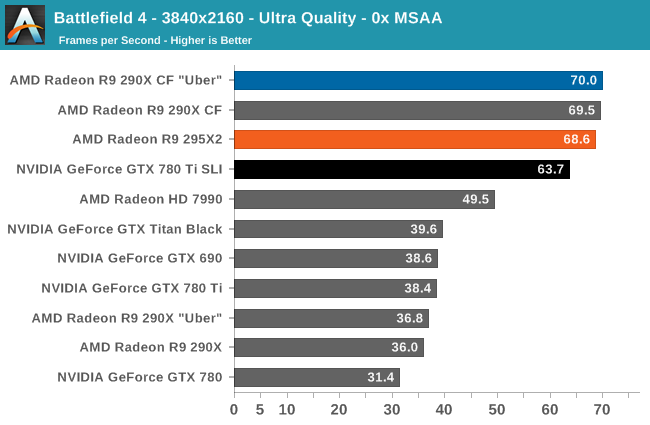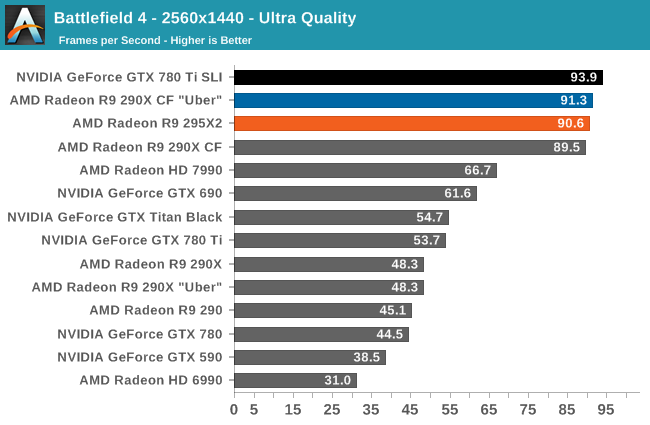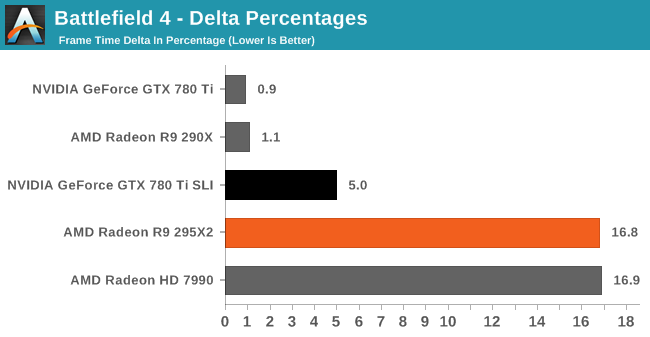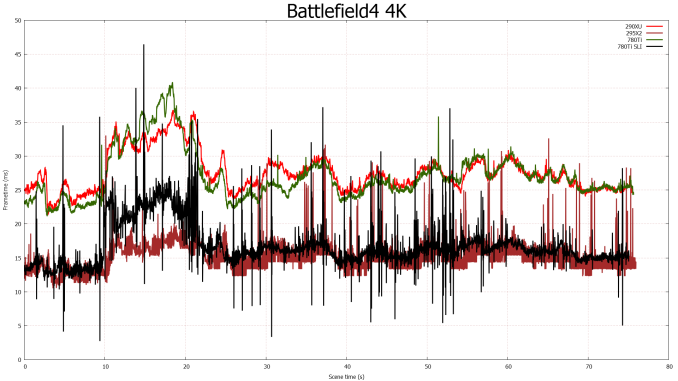The AMD Radeon R9 295X2 Review
by Ryan Smith on April 8, 2014 8:00 AM EST- Posted in
- GPUs
- AMD
- Radeon
- Radeon 200
Battlefield 4
Our current major multiplayer action game of our benchmark suite is Battlefield 4, DICE’s 2013 multiplayer military shooter. After a rocky start, Battlefield 4 has finally reached a point where it’s stable enough for benchmark use, giving us the ability to profile one of the most popular and strenuous shooters out there. As these benchmarks are from single player mode, based on our experiences our rule of thumb here is that multiplayer framerates will dip to half our single player framerates, which means a card needs to be able to average at least 60fps if it’s to be able to hold up in multiplayer.



As is the case in a few of our other games, whether it’s AMD who’s winning or NVIDIA who’s winning depends on the resolution. At 2160p with Ultra settings (and no MSAA) it’s AMD on top, with the 295X2 capable of delivering 68fps. This is safely past the 60fps threshold needed to ensure that minimum framerates don’t drop below 30fps in multiplayer. Otherwise at 1440p the NVIDIA GTX 780 Ti SLI setup pulls ahead, however the 295X2 is right on its tail.
In the meantime this game is also a good example of just how much faster than the 7990 the 295X2 is, despite the fact that both products are based on high-end (for their time) 28nm GPUs. The 295X2 ends up being over 40% faster at both 2160p and 1440p, showing just how far AMD has come in single card dual-GPU performance in the last year.


Shifting to our delta percentage benchmarks, we once more find that the 295X2 has no problem staying within the 20% threshold needed for smooth frame pacing. Though overall NVIDIA does hold an edge, especially at 1440p.












131 Comments
View All Comments
Gizmosis350k - Sunday, May 4, 2014 - link
A CPU block you mean?C4$hFlo - Monday, May 12, 2014 - link
Emphasis on "moderately good". Years of operation will require maintenance on any LC solution. Moderately priced solutions such as Thermaltake don't hold up as well, the liquid gets discolored, tubing cooks and becomes brittle, pumps fail etc... Liquid cooling isn't something to do on the cheap.Saifur - Monday, December 8, 2014 - link
Hello , can someone please advice , i have 4930 K , OC to 4.3 Ghz , 16 gig ram also OC ( slightly ) and i am planning on getting the r9 295x2 . Will the power supply i have be sufficient for this card ? This is my PSU - Cooler Master V850 - 850W . THanksC4$hFlo - Monday, May 12, 2014 - link
A pump, a reservoir, two waterblocks, a fan/pump controller and a plethora of connectors and tubing will probably end up costing the difference between an R9295X2 and two R290X water cooled. Remember, with the R9195X2 you get a free closed loop that requires no maintenance. After succesfully running dual HD6970s in a koolance loop for 3 years, I can say a free closed loop is a great selling point for me.RoboJ1M - Friday, May 2, 2014 - link
It'll be interesting when a card like this does not have 2xGPU + 2x4GB but 2xGPU + 8GBEventually I guess we'll see the results of the HSA push trickle down (up?) to performance parts like this.
Hey, maybe we'll see a 4xGPU + 16GB...
AMDisDead - Tuesday, April 8, 2014 - link
Almost faster than 780 Ti SLI and draws hundrets more W. AMD lunatics in full glory.willis936 - Tuesday, April 8, 2014 - link
A dual GPU is arguably worth the extra 100W compared to the drawbacks of SLI in pretty much every use case. The deciding factor is upfront cost.Guspaz - Tuesday, April 8, 2014 - link
Dual GPU (from either company) has all the same limitations/drawbacks of SLI/Crossfire. It's literally the same thing.lehtv - Wednesday, April 9, 2014 - link
No, they don't have the same limitations. Since you don't have to populate two PCIe slots, you can install the 295X2 onto a microATX or ITX motherboard and case, or just use it in a regular ATX board that doesn't support x8/x8. For some, it could also matter to not have to populate a second PCIe slot and use additional PSU cables, even if their motherboard and PSU fully supported crossfire 290X. The ability to use only one PCIe slot has always been the primary selling point of any dual GPU card, ever.Musaab - Wednesday, April 9, 2014 - link
If you want to pay 1500 $ for video card and 2000+ for 4K monitor and 200+ for power supply then you are the one who pay 1500$ on core i 7 4960x with ROG X79. why should you think about 8x/8x motherboard lanes don't forget 32 GB 2400+ DDR 3 and two extra fast ssd . friend you needn't a case you need a cabinet